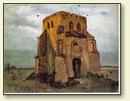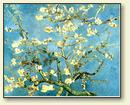| Relevant paintings: 
"Doctor Gachet's Garden in Auvers," Vincent van Gogh
[Enlarge]

"Marguerite Gachet in the Garden," Vincent van Gogh
[Enlarge]

"Church at Auvers," Vincent van Gogh
[Enlarge]

"Old Cemetery Tower at Nuenen," Vincent van Gogh
[Enlarge]

"Still Life: Pink Roses in a Vase," Vincent van Gogh
[Enlarge]

"Still Life: Vase with Roses," Vincent van Gogh
[Enlarge]

"Still Life: Vase with Irises against a Yellow Background," Vincent van Gogh
[Enlarge]

"Still Life: Vase with Irises," Vincent van Gogh
[Enlarge]

"Blossoming Almond Tree," Vincent van Gogh
[Enlarge]

"L'Arlesienne (Madame Ginoux)," Vincent van Gogh
[Enlarge]

"L'Arlesienne (Madame Ginoux)," Vincent van Gogh
[Enlarge]

"Self-Portrait," Vincent van Gogh
[Enlarge]

"Portrait of Doctor Gachet," Vincent van Gogh
[Enlarge]

"Sketch of Arlésienne & Puvis,"
[Enlarge]
|
Highlighting Theo - health - Turn off highlighting
W22 1
Auvers-sur-Oise, 5 June 1890
My Dear Sister,
I ought to have replied to the two letters I received when I
was still at St. Rémy, but the journey, the work
and a lot of new emotions caused me to postpone from day to day
until this moment writing you a letter. I was greatly
interested to hear that you nursed the patients at Walloon
Hospital. It is certainly in this way that one learns a lot of
the best and most necessary things one can ever learn, and I
for one am very sorry that I know nothing, or next to nothing,
about this.
It was a great happiness to me to see Theo again, and to
make the acquaintance of Jo and the little one. Theo's cough
was worse than it was when I left him two years ago, but when I
talked with him and saw him at close range it seemed certain to
me that, all things considered, there is a change rather for
the better, and Jo is full of good sense, as well as good
intentions.
The little one is not weakly but on the other hand he is not
strong either. It is a good system that, when you are living in
a big city, the wife goes into the country for her confinement,
and stays there with her baby for some months. You know what it
is, the first confinement in particular is a very serious
thing, and they never could have acted better or otherwise than
they did. I hope that before long they will come to Auvers for
a few days.
As for myself, the travelling and all the rest have come off
very well so far, and coming back north has been a great
distraction for me. And then I have found a true friend in Dr.
Gachet, something like another brother, so much do we resemble
each other physically and also mentally. He is a very nervous
man himself and very queer in his behaviour; he has extended
much friendliness to the artists of the new school, and he has
helped them as much as was in his power. I painted his portrait
the other day, and I am also going to paint a portrait of his
daughter, who is nineteen years old. He lost his wife some
years ago, which greatly contributed to his becoming a broken
man. I believe I may say we have been friends from the very
first, and every week I shall go stay at his house one or two
days in order to work in his garden, where I have already
painted two studies, one with southern plants, aloes,
cypresses, marigolds; the other with white
roses, some vines and a figure, and a cluster of ranunculuses
besides. Apart from these I have a larger
picture of the village church - an effect in which the building
appears to be violet-hued against a sky of simple deep blue
colour, pure cobalt; the stained-glass windows appear as
ultramarine blotches, the roof is violet and partly orange. In
the foreground some green plants in bloom, and sand with the
pink flow of sunshine in it. And once again it
is nearly the same thing as the studies I did in Nuenen of the
old tower and the cemetery, only it is probably that now the
colour is more expressive, more sumptuous.
But during the last weeks at St. Rémy I worked
like a man in a frenzy, especially on bunches of flowers, roses
and violet irises. I brought along a relatively large picture
for Theo's and Jo's little boy - which they hung over the piano
- white almond blossoms - big branches against a sky-blue
background - and they also have a new portrait
of the Arlésienne in their apartment.
My friend Dr. Gachet is decidedly enthusiastic about
the latter portrait of an Arlésienne, which I
also have a copy of for myself - and also about a
self-portrait, which I am very glad of, seeing
that he will urge me to paint figures, and I hope he is going
to find some interesting models for me to paint.
What impassions me most - much, much more than all the rest
of my métier - is the portrait, the modern
portrait. I seek it in colour, and surely I am not the only one
to seek it in this direction. I should like - mind you,
far be it from me to say that I shall be able to do it,
although this is what I am aiming at - I should like to
paint portraits which would appear after a century to people
living then as apparitions. By which I mean that I do not
endeavour to achieve this by a photographic resemblance, but by
means of our impassioned expressions - that is to say, using
our knowledge of and our modern taste for colour as a means of
arriving at the expression and the intensification of the
character. So the portrait of Dr. Gachet shows you a face the
colour of an overheated brick, and scorched by the sun, with
reddish hair and a white cap, surrounded by a rustic scenery
with a background of blue hills; his clothes are ultramarine -
this brings out the face and makes it paler, notwithstanding
the fact that it is brick-coloured. His hands, the hands of an
obstetrician, are paler than the face. Before him, lying on a
red garden table, are yellow novels and a foxglove flower of a
somber purple hue.
My self-portrait is done in nearly the same way but the blue
is the fine blue of the Midi, and the clothes are a light
lilac. The portrait of the Arlésienne has a drab
and lusterless flesh colour, the eyes calm and very simple, a
black dress, the background pink, and with her elbow she is
leaning on a green table with green books.
But in the copy which is in Theo's possession the dress is
pink, the background yellowish white, and the front of the open
bodice is of muslin of a white colour emerging into green.
Among all these colours only the hair, the eyebrows, and the
eyes form black spots.
I do not succeed in making a good sketch of it.
There is a superb picture by Puvis de Chavannes at the
exhibition. The figures of the persons are dressed in bright
colours, and one cannot tell whether they are costumes of today
or on the other hand clothes of antiquity.
On one side two women, dressed in simple long robes, are
talking together, and one the other side men with the air of
artists; in the middle of the picture a woman with her child on
her arm is picking a flower off an apple tree in bloom. One
figure is forget-me-not blue, another bright citron yellow,
another of a delicate pink colour, another white, another
violet. Underneath their feet a meadow dotted with little white
and yellow flowers. A blue distance with a white town and a
river. All humanity, all nature simplified, but as they
might be if they are not like that.
This description does not tell you anything - but when one
sees this picture, when one looks at it for a long time, one
gets the feeling of being present at a rebirth, total but
benevolent, of all things one should have believed in, should
have wished for - a strange and happy meeting of very distant
antiquities and crude modernity.
I was very much pleased to see André Bonger
again too; he was looking strong and calm, and, upon my word,
reasoned with much correctness on artistic subjects.
I was extremely glad that he was in Paris during the time I
was there.
Once more thanks for your letters. I hope to see you soon, I
embrace you in thought.
Yours, Vincent
-
Written in French.
At this time, Vincent was 37 year oldSource:
Vincent van Gogh. Letter to Wilhelmina van Gogh. Written 5 June 1890 in Auvers-sur-Oise. Translated by Robert Harrison, edited by Robert Harrison, number W22.
URL: https://www.webexhibits.org/vangogh/letter/21/W22.htm.
This letter may be freely used, in accordance with the terms of this site.
|